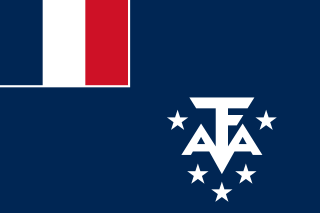
Europa Island, in Malagasy Nosy Ampela is a 28-square-kilometre (11 sq mi) low-lying tropical atoll in the Mozambique Channel, about a third of the way from southern Madagascar to southern Mozambique. The island had never been inhabited until 1820, when the French family Rosier moved to it. The island officially became a possession of France in 1897.

Pygomeles is a genus of skinks, lizards in the family Scincidae. The genus is endemic to Madagascar.
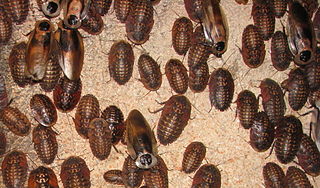
Giant cockroaches, or blaberids, are the second-largest cockroach family by number of species. Mostly distributed in warmer climates worldwide, this family is based on the American genus Blaberus, but much of the diversity is also found in Africa and Asia.
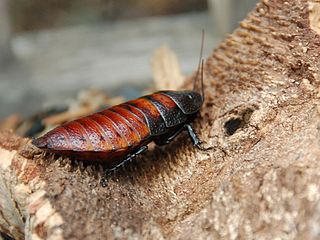
The Madagascar hissing cockroach, also known as the hissing cockroach or simply hisser, is one of the largest species of cockroach, reaching 5 to 7.5 centimetres at maturity. They are native to the island of Madagascar, which is off the African mainland, where they are commonly found in rotting logs. It is one of some 20 known species of large hissing roaches from Madagascar, many of which are kept as pets, and often confused with one another by pet dealers; in particular, G. portentosa is commonly confused with G. oblongonota and G. picea.

Tristerix is a genus of mistletoe in the family Loranthaceae, native to the Andes, ranging from Colombia and Ecuador to Chile and Argentina. They are woody perennials usually occurring as aerial parasites, are pollinated by hummingbirds and flowerpiercers, with seed-dispersal generally by birds but occasionally by mammals (Dromiciops). The genus is distinguished from other New World Loranthaceae by its simple, terminal, racemose inflorescences, together with its of 4- or 5-merous flowers, versatile anthers, and the presence of endosperm. Further differences include fused cotyledons and the absence of epicortical roots.

The Madagascar buttonquail is a species of bird in the buttonquail family, Turnicidae, that is endemic to Madagascar and a few small islands nearby. It is a ground-dwelling species with an unusual breeding biology in which the sexual dimorphism is reversed, with female being more brightly coloured than the male and it is the male that incubates the eggs and mainly cares for the young.

The brown-tailed mongoose, brown-tailed vontsira, Malagasy brown-tailed mongoose, or salano is a species of mammal in the family Eupleridae. It is endemic to Madagascar. Its natural habitat is moist lowland tropical forest. It is threatened by habitat loss.
Aimée Antoinette Camus was a French botanist. She was best known for her study of orchids and oaks. Camus also has the legacy of authoring the second highest number of land plant species among female scientists, in total naming 677 species.
Neostapfiella is a genus of Madagascan plants in the grass family.

Neritina pulligera, common name the dusky nerite, is a species of freshwater snail, a gastropod mollusk in the family Neritidae.
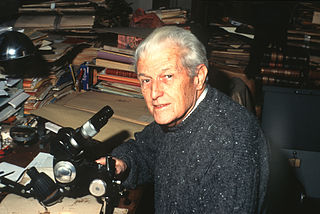
Jean Marie Bosser, sometimes listed as Jean-Michel Bosser was a French botanist and agricultural engineer who worked extensively in Madagascar and Mauritius.

Gromphadorhina oblongonota, the wide-horned hisser, is a large, flightless species of hissing cockroach from southern Madagascar, and one of four members of the genus Gromphadorhina. This species is common in the pet trade, but it is difficult to distinguish from G. portentosa and is commonly confused with it, although oblongonota tends to be significantly larger and somewhat darker than portentosa.

Gromphadorhina is a genus of large, flightless cockroaches from southern Madagascar; they are typical of the tribe Gromphadorhini and common in the pet trade. In the older literature, the name is sometimes misspelled as Gromphadorrhina.

Gromphadorhini, the hissing cockroaches, is a tribe of large, flightless cockroaches comprising 20 known species in six genera, all but one from the island of Madagascar where they inhabit wood, leaf litter or rocky crevices in forest or woodland; the one exception, Elliptorhina lefeuvri, being from Europa Island off the coast of Madagascar. Many of the species are popular in the pet trade.

Charles Antoine Domergue was a French naturalist, ornithologist, herpetologist, spelunker and geologist who spent much of his life in Madagascar. He also dealt with the effects of pollution.
Entypesa is a genus of African mygalomorph spiders in the family Entypesidae. It was first described by Eugène Louis Simon in 1902. Originally placed with the curtain-web spiders, it was transferred to the funnel-web trapdoor spiders in 1985, then to the Entypesidae in 2020. It is a senior synonym of Pseudohermacha.

Sapindoideae is a subfamily of flowering plants in the soapberry family, Sapindaceae. It includes a number of fruit trees, including lychees, longans, rambutans, and quenepas.

Elliptorhina javanica, also known as the Halloween hisser, is a large species of wingless cockroach native to the island of Madagascar.
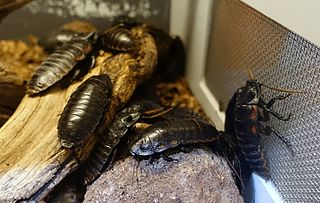
Princisia vanwaerebeki, commonly known as the vibrant hisser, is a large, flightless species of hissing cockroach in the family Blaberidae, and the only member of the genus Princisia. It is endemic to southeastern Madagascar, and sometimes seen in the pet trade.















